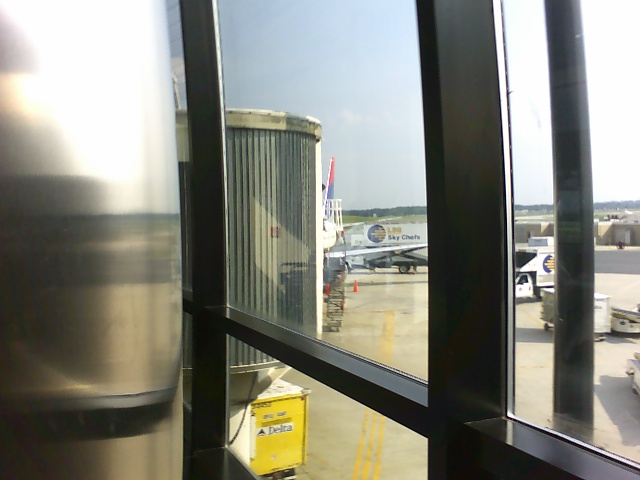My mental absence or recent aversion to controversy has not gone unnoticed. Verses have been penned, lamentations expressed, and gauntlet thrown. The fluff pieces of the past couple weeks, it seems, weren't meaty enough for some -- although the post about Metro and Personal Rapid Transit drew several comments, many of which, I think, were from non-Howard County transit partisans.
Anyway, I want to quickly respond to a few things written over the last couple days about the zoning reforms being pushed by the council Democrats. As I've said before, I am supportive of what they are trying to do, even though these are only tweaks to a system in need of a full-scale overhauling. And, though I understand why the council Democrats took the larger proposed changes off the table, I think that to a large part the criticism they received for their plan was unwarranted. But, then, I also think that council members who dealt with numerous controversial and sticky zoning cases -- Maple Lawn, Town Center, Comp Zoning and Comp Lite -- would do a better job at amending the process than a group of newbies. But, political realities dictated otherwise, which is the way it goes.
More specifically, I want to respond to David Keelan's post in response to The Sun's story about Monday's hearing on the zoning bills. It sounds like those who offered testimony at the hearing, including Keelan, generally supported most of the proposed changes, but not without offering several suggestions for how to tweak the tweaks. The Democratic sponsors of the bills responded to the Sun thusly:
“We’re going to take the feedback and make them better,” said east Columbia Democrat Calvin Ball
The idea of using voluntary mediation in Zoning Board cases took the most fire from a baker’s dozen speakers, and Guzzone, a North Laurel-Savage Democrat, suggested changing that bill.
Added Ulman, a west Columbia Democrat: “We’ll work through potential changes.”
It sounds like they're doing their jobs as legislators. That is, proposing bills, soliciting feedback, and making changes to the bills accordingly. Here's what Keelan had to say about these three quotes:
Make it better, changing the bill, and POTENTIAL changes.
Is it me? It has to be me. Am I reading something into Ulman’s words that isn’t there? Potential changes? Why are Ball and Guzzone on board with changes and Ulman will look at that potential. It comes off as arrogant.
In answer to his first two questions, yes. Parsing written policies or laws is fine, but doing so to a five-word quote without context is beyond reasonable speculation. Although I wasn't there and didn't watch the hearing on GTV, I'm pretty sure that there were numerous, non-uniform suggestions made by the participating citizens, meaning the council members should probably consider all of the
potential changes and decide upon them using their best judgment, which is precisely what we elected them to do.
Now, if Keelan perceives this statement as arrogant, who am I to argue someone else's perception? But he did ask the questions.
The second thing I want to respond to regarding this slate of bills is a
comment made by blog poet laureate (and I mean that honestly -- I really enjoyed your poem, Mary) Mary Smith on Keelan's blog. She says:
Does anyone really think that any member of the sitting council cares about citizen input on zoning? If so, based on what? They don’t care! Come on. None of them.
I know not everyone in Howard County is as concerned about Town Center as me or other Columbians. And I know memories are often short. But I think it's worthwhile to look back to almost exactly three years ago -- my 26th birthday to be exact -- when the first hearing was held on the Rouse Company's hubristic proposal to forge ahead with new development in Town Center against the almost unanimous wishes of the community.
During that entire process, in which I was intimately involved, both Ulman and Guzzone adamantly supported citizens and worked dilligently to ensure the ill-conceived plans of Rouse Co. (later GGP) did not move forward. They both made abundantly clear that a plan involving and supported by residents would be the only way large-scale additional development would be approved. Out of this drawn-out imbriolgio came the Columbia charrette, which was
the most citizen-driven planning process this county has ever known.
Now, I know there are some who feel the citizens were shut out of or poorly informed about the charrette, that the outcomes were predetermined. I put very little stock in these arguments, mainly because of the tremendous work still being done by the Focus Group and others to craft an agreeable plan. I would also point to the fact that, after a meeting in February when citizens expressed concern about the timetable in which the plan was being developed, the county agreed to slow things down.
Hmm, there was something else I wanted to say but I forgot...
Oh yeah, the proposal to add mediation as a possible solution to developer-citizen impasses. For some reason this seems to be the most maligned of the proposed zoning changes, but I really like it. The argument against it is that zoning decisions and zoning laws are black and white and there's no need to mediate when the issues are black and white. While some are, many of these cases aren't black and white. The zoning board case involving Rouse Co.'s initial Town Center proposal wasn't clear cut and the charrette, I think, was a form of mediation.
Of course, my opinion of mediation is probably a result of my predilection for compromise (which is why I'm an awful partisan) and my belief that
Euclidean zoning should be banished. But that, my friends, is a whole 'nother story.
(Note: Something went totally haywire when I ran spellchecker and a bunch of words got thrown around. I've tried to correct the multitude of errors, but let me know in comments if you spot something amiss. Thanks!)
 Keeping up with each discussion, which can involve just one or sometimes many Anonymouses, ain't easy. The lack of aliases also makes discussion for other commenters difficult.
Keeping up with each discussion, which can involve just one or sometimes many Anonymouses, ain't easy. The lack of aliases also makes discussion for other commenters difficult.







